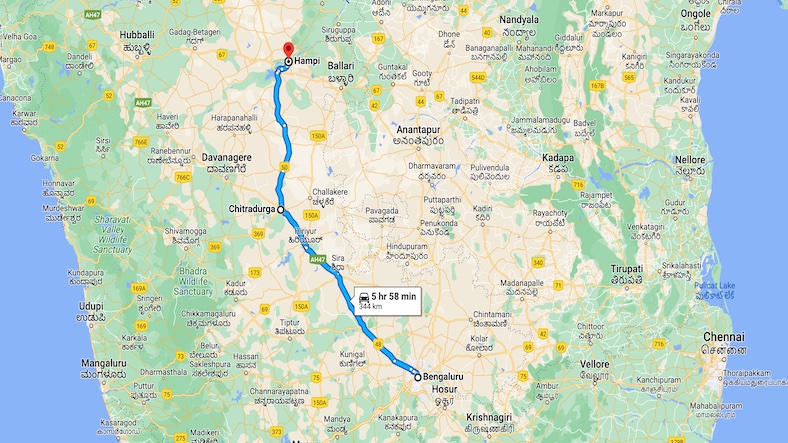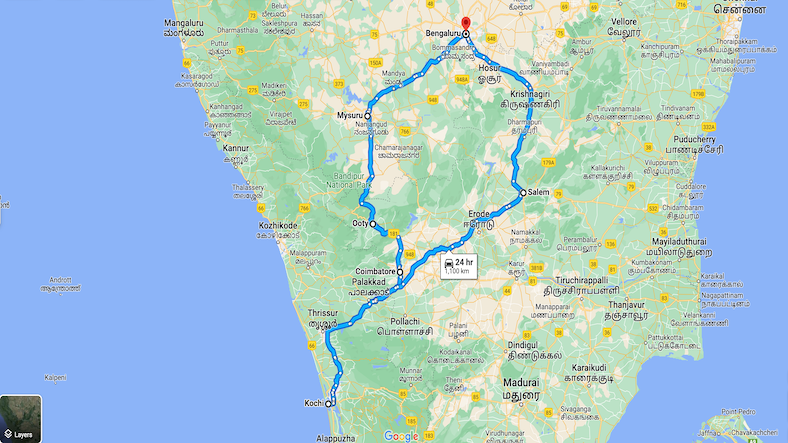A solo trip from Bangalore to Hampi is one of the most rewarding getaways for travelers who enjoy history, architecture, landscapes and a slow pace of life. Hampi, the ancient capital of the Vijayanagara Empire, was once one of the richest and most powerful kingdoms in South India. Today, it stands as a UNESCO World Heritage Site featuring monumental temples, massive boulders, riverbank ruins and villages that preserve centuries of culture.
Route and Distance from Bangalore to Hampi
Route: Bangalore → Tumkur → Chitradurga → Hospet → Hampi
Total Distance: ~340 km
Travel Time: 6 to 7 hours by road
You will travel primarily on NH48 and NH50, both of which offer smooth, wide highways. After crossing Chitradurga, the landscape slowly transforms into rocky hills, windmills and scattered granite formations. These boulder clusters are your first glimpse of the terrain that defines Hampi’s unique geography.
Day 1: Bangalore to Hampi + First Glimpse of the Ruins
1. Early Morning Start
Leave Bangalore as early as possible to avoid Tumkur Road traffic. You will find several reliable breakfast places before Tumkur and near Sira. Once you cross Chitradurga, the views become more scenic with fort walls and windmill fields.
2. Reaching Hampi or Hospet
You will reach Hampi by noon or early afternoon. Hospet (Hosapete), which is 12 km from Hampi, offers more hotel options, while Hampi Bazaar and Virupapur Gadde (Hippie Island side) keep you closer to the monuments and the relaxed traveler scene.
3. Visit the Virupaksha Temple
Begin your exploration with the Virupaksha Temple, the oldest functioning temple in Hampi dating back to the 7th century. Dedicated to Shiva, this temple still follows traditional rituals. The towering gopuram, detailed carvings and historic paintings offer a glimpse into Hampi’s spiritual heritage.
4. Walk Through Hampi Bazaar
Right outside the temple lies Hampi Bazaar, once a bustling trading street of the Vijayanagara Empire. The long pillared structures on either side were once merchant shops. Today, they create a living museum-like experience.
5. Sunset at Hemakuta Hill
End your day at Hemakuta Hill, a vast cluster of small shrines overlooking the Hampi landscape. The gentle slopes and open views make it ideal for sunset photography and quiet reflection.
Night Stay: Hampi or Virupapur Gadde.
Day 2: Exploring Hampi’s Architectural Masterpieces
Begin the day early since afternoons can be hot and exhausting.
1. The Vittala Temple Complex
Your first stop should be the Vittala Temple, the most iconic monument in Hampi. Highlights include:
- The Stone Chariot
- Musical pillars (famous for producing notes when tapped)
- Intricately carved mandapas
- A sprawling temple courtyard
This complex represents the height of Vijayanagara craftsmanship and architecture.
2. The Royal Enclosure
Next, head to the Royal Enclosure, the administrative and ceremonial center of the Vijayanagara Empire. Explore:
- Mahanavami Dibba: A giant ceremonial platform used for royal events
- Lotus Mahal: An Indo-Islamic architectural blend inside the Zenana Enclosure
- Elephant Stables: A massive row of domed chambers showcasing the empire’s organizational skill
- Queen’s Bath: A square, beautifully carved bathing area with intricate arches
These structures reveal how advanced and planned Hampi’s urban layout once was.
3. Hazara Rama Temple
A short walk from the Royal Enclosure brings you to the Hazara Rama Temple, famous for its narrative panels depicting the Ramayana. The outer walls act as a historic storyboard.
4. Other Important Monuments Nearby
You can also visit:
- Ugra Narasimha statue
- Sasivekalu Ganesha
- Monolithic Nandi (bull statue)
These iconic sculptures are major highlights of Hampi’s archaeological landscape.
5. Cross to Anegundi Village
Take a coracle ride across the Tungabhadra River to Anegundi, a village older than Hampi itself. Local legends associate this region with Kishkindha from the Ramayana. The village features paddy fields, small shrines, narrow roads and a peaceful rural atmosphere.
End your day at Matanga Hill or at any riverside viewpoint.
Night Stay: Hampi or Anegundi side.
Google Ad 1
Day 3: Riverside Ruins + Return to Bangalore
1. Krishna Temple Complex
Start the day with the Krishna Temple, built by King Krishnadevaraya. The surrounding markets, pavilions and pillars show how vibrant this region was during the 16th century.
2. Explore the Hippie Island Side (Optional)
Cross the river again toward Virupapur Gadde, known for its guesthouses, cafés and backpacker-friendly atmosphere. If you enjoy climbing, go up Anjanadri Hill, traditionally considered the birthplace of Hanuman. The viewpoint offers a full panoramic view of Hampi’s rocky terrain and river system.
3. Return Journey
Begin the ride back by noon or early afternoon to reach Bangalore by evening.
Best Time to Visit Hampi
- October to February: Ideal weather, pleasant for walking and climbing
- Summer (March–May): Very hot, temperatures above 38°C
- Monsoon (June–September): Beautiful greenery but slippery rocks
For a solo traveler, winter months are the most comfortable.
Food Options in Hampi
Hampi offers a mix of local village food and international options. In Hampi Bazaar, you will find simple South Indian meals, thalis and dosas. Across the river, cafés offer continental dishes, Israeli meals, pasta, pancakes and fresh juices.
Popular local items include:
- Ragi mudde with sambar
- Lemon rice
- Traditional South Indian thali
- Home-cooked rotis and curries in Anegundi
Many homestays also prepare fresh breakfasts on request.
Safety and Practical Tips for Solo Travelers
- Start sightseeing early to avoid heat.
- Carry plenty of water and a power bank.
- Wear shoes with good grip for climbing hills.
- Avoid isolated paths after sunset.
- Consider hiring a local certified guide for deeper historical insight.
- Keep cash handy since digital payments may fail in some areas.
Why Hampi is Ideal for a Solo Trip
Hampi is compact, easy to navigate and welcoming to travelers. Locals are friendly, and the region attracts backpackers, photographers, history lovers and slow travelers from around the world. Whether you want to walk through centuries-old ruins, reflect near riverbanks or capture landscapes filled with boulders and temples, Hampi offers a balanced mix of solitude, culture and history.
A solo trip to Hampi is more than a journey. It is an experience that blends heritage, nature and silence, allowing you to step back into a forgotten empire while enjoying the peaceful pace of rural Karnataka.
For more detailed travel guides, explore PeoplesBLOG.















